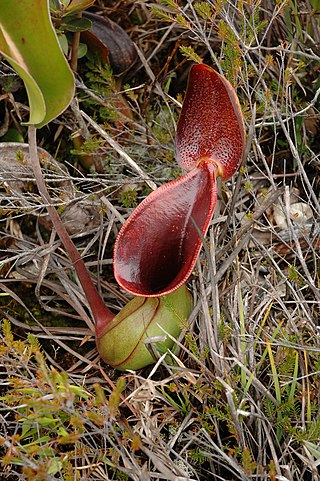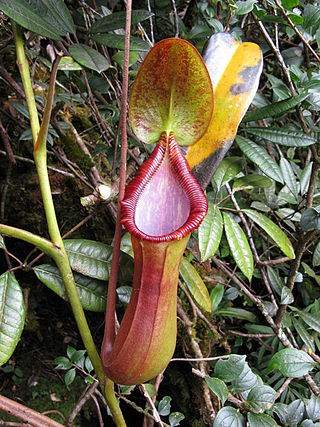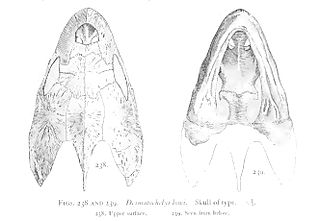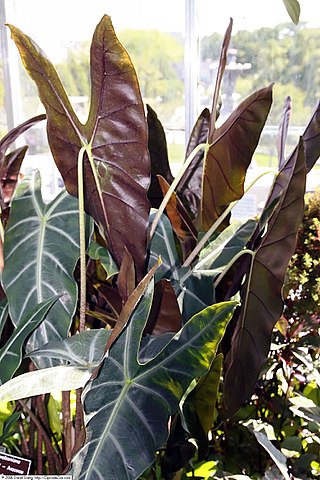
Nepenthes lowii, or Low's pitcher-plant, is a tropical pitcher plant endemic to Borneo. It is named after Hugh Low, who discovered it on Mount Kinabalu. This species is perhaps the most unusual in the genus, being characterised by its strongly constricted upper pitchers, which bear a greatly reduced peristome and a reflexed lid with numerous bristles on its lower surface.

Nepenthes fusca, or the dusky pitcher-plant, is a tropical pitcher plant endemic to Borneo. It is found throughout a wide altitudinal range and is almost always epiphytic in nature, primarily growing in mossy forest.

Nepenthesinfauna are the organisms that inhabit the pitchers of Nepenthes plants. These include fly and midge larvae, spiders, mites, ants, and even a species of crab, Geosesarma malayanum. The most common and conspicuous predators found in pitchers are mosquito larvae, which consume large numbers of other larvae during their development. Many of these animals are so specialised that they cannot survive anywhere else, and are referred to as nepenthebionts.

Nepenthes × trusmadiensis, or the Trus Madi Pitcher-Plant, is a natural hybrid of two famous Bornean pitcher plant species: N. lowii and N. macrophylla. It is restricted to Mount Trus Madi, where both of its parent species are sympatric.
Pseudocampylaea lowii is an extinct species of air-breathing land snail, a terrestrial pulmonate gastropod mollusc in the family Hygromiidae, the hairy snails and their allies.

Low's squirrel is a species of rodent in the family Sciuridae. It is found in Borneo and nearby islets. Its former subspecies S. l. robinsoni from Sumatra and the Malay Peninsula and S. l. natunensis from the Natuna islands have recently been given species status.

Desmatochelys is an extinct genus of sea turtles belonging to the family Protostegidae. This genus contains two known species, D. lowii and D. padillai. D. lowii was first discovered in 1895, followed by D. padillai in 2015. Having been estimated at over 120 million years old, D. padillai is currently the oldest known species of sea turtle.

Paphiopedilum lowii is a species of orchid that occurs in Indonesia, Malaysia, and the Philippines.

Phalaenopsis lowii is a species of orchid found from Myanmar to western Thailand.

Phinizy Swamp Nature Park is a 1,100-acre (450 ha) nature park in Augusta, Georgia. The park contains wetlands and woodlands and has a campus for water research and environmental education, which includes a visitor center. It has many bald cypresses draped in Spanish moss and forests of loblolly trees. Birds commonly found at Phinizy Swamp include: red-shouldered hawks, great blue herons, sora, wood ducks and bald eagles. Sometimes the park yields rarities for Georgia, including black-bellied whistling ducks, which nested in the park in 2010, and a cave swallow, in 2004.
Rhizanthes lowii is a species of parasitic flowering plant without leaves, stems, roots, or photosynthetic tissue. It grows on the roots of the Tetrastigma vine. It includes the specimens with the largest measured flowers in Rhizanthes, from 25 to 43 cm across. The flowers are endothermic, not only producing their own heat, but they also have the rare ability to regulate their own temperature.

Sarothrocera lowii is a species of beetle in the family Cerambycidae, and the only species in the genus Sarothrocera. It was described by White in 1846.

Uranotaenia is a genus of mosquitoes containing at least 270 species. It is the only member of the tribe Uranotaeniini.

Pseudoficalbia is a subgenus of the mosquito genus Uranotaenia with 153 species. It was originally created as a genus by Frederick Vincent Theobald in 1911 ; however, it was later treated as a subgenus of Uranotaenia, and then was made a synonym of the same genus. It was later restored as a subgenus by E.L. Peyton in 1972.
Uranotaenia (Uranotaenia) campestris is a species of mosquito belonging to the genus Uranotaenia. It is found in Thailand, Sri Lanka, Bangladesh, Cambodia, India, Indonesia, Malaysia, Nepal, Timor, and Vietnam.
Uranotaenia (Pseudoficalbia) srilankensis is a species of zoophilic mosquito belonging to the genus Uranotaenia. It is endemic to Sri Lanka, and first documented from Peradeniya.

Uranotaenia sapphirina is a species of mosquito in the family Culicidae. It is a common species found throughout eastern North America. Uranotaenia sapphirina was found from an experiment to be unlike Uranotaenia lowii which feeds only on anurans, instead feeding exclusively on annelid hosts such as earthworm and leeches.

Alocasia longiloba is a species of flowering plant in the family Araceae. It is the namesake of a species complex. The complex has a widespread distribution; Guangdong, Hainan, and southern Yunnan in China, mainland Southeast Asia, and western and central Malesia.













